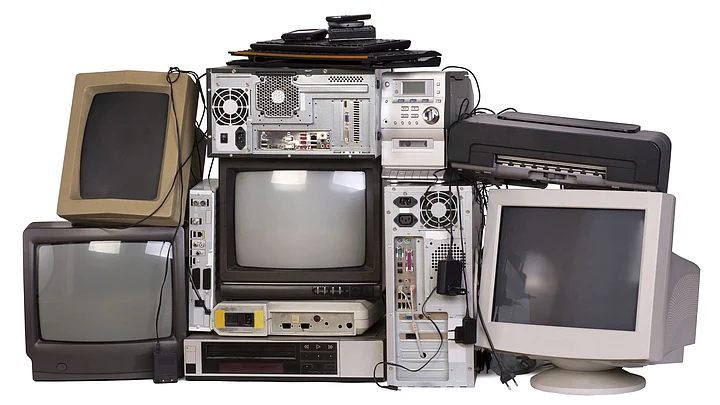The world generates about 45 million tonnes of e-waste, annually, equivalent to about 4500 Eiffel Towers in height, or about the size of Manhattan!
The Global E-Waste Monitor 2017 report estimates that 80 percent of this waste in higher income countries is either incinerated, dumped into lower income countries, traded, or recycled under inferior conditions. United Nations Environment Programme (UNEP) estimates that 90 percent of the global e-waste, valued at US$ 19 billion is illegally dumped or traded each year.
Collection rates are abysmally low at 20 percent which suggests that much of the economic value in e-waste from materials such as gold, copper, platinum, palladium, etc, is lost to landfill sites.
India is one of the largest illegal dumping grounds for large-scale dumping of e-waste and is among the top five generators of hazardous e-waste globally.
E-waste includes discarded computer parts such as monitors and motherboards, keyboards, mobile phones, chargers, headphones, television sets, power chords, wires, and cables.
The Central Pollution Control Board (CPCB) estimates that during FY 2019-2020, India generated about one million tonnes of e-waste from 21 different types of electrical and electronic equipment (EEE). The policy paper released by the Ministry of Electronics and Information Technology (MeitY) estimated that 3.2 million tonnes of e-waste was generated in India in 2019, of which a mere 10 percent was collected and recycled.
This inconsistency in estimates of CPCB and MeitY points to the challenge of accurately estimating the amount of e-waste generated in the country. Additionally, an undisclosed quantity of e-waste accumulates from the legal and illegal e-waste imports, which is not accounted for in the CPCB estimates.
The Ecological Footprint of E-waste
E-waste has contributed significantly to the total waste in India. Municipal solid waste from landfills releases methane into the air; a gas with high global warming potential.
Incineration of e-waste releases into the air, harmful chemicals including metals such as copper, aluminum, and flame retardants such as Polybrominated diphenyl ethers, which seep into the soil and water, with the potential risk of being ingested by humans and animals.
Throughout the life cycle of EEE, from extraction, processing, transportation to end-of-life disposal, large amount of energy is consumed, adding to the Greenhouse gas (GHG) inventory, polluting the environment, and adversely impacting health.
The environmental cost of EEE is rarely factored in by brands due to poor regulation and its implementation. If these costs are factored in, products are likely to become more expensive. Consequently, in the competitive markets of today, brands have little incentive to adopt environmentally sustainable practices.
Formalizing the Value Chain
Materials such as gold, palladium, copper, etc., found in e-waste can be recovered and reused, without deterioration in their material properties, thus conserving energy and natural resources, and reducing pollution. World Economic Forum estimated that there is 100 times more gold to be found in a tonne of smartphones than in a tonne of gold ore!
Successful implementation of MeitY’s circular economy vision for India’s e-waste requires a paradigm shift, including holding brands accountable for the waste they generate and engendering an attitudinal shift among the general public.
India’s flawed implementation could be attributed to the presence of a largely unorganized informal recycling sector, which employs millions of poor people, deploys primitive technologies, and has little awareness about hazardous e-waste toxins.
India’s manufacturing chain for electronics is highly fragmented, with components, parts and even assembled products being imported. In the organized sector, e-waste recycling is very capital intensive.
The government could have incentive mechanisms to encourage waste collectors to hand over the waste to organized recyclers for environment-friendly processing. Digitization can be leveraged to track and monitor e-waste, set high recycling quotas, and institutionalize a penalty and incentive scheme.
Third party organizations possessing requisite expertise skills can be enrolled to tackle e-waste, through innovative business models. Attero, Saahas Zero Waste, Sanshodhan, and Namo e-waste are examples of startups at the forefront of effective e-waste management.
Despite the Extended Producer Responsibility (EPR) regulation, it is a challenge to ensure compliance by thousands of producers and importers. Producers have ambiguous incentive schemes that consumers are unaware of. Reaching out to millions of individual consumers is infeasible.
The government could mandate every EEE manufacturer to register with a third party, that could locally collect and treat the waste. Producers could finance this third-party collection and treatment organization through a graded membership fee. Brands should carry detailed information about their take-back systems on their websites and product packs. A toll-free number could enable consumers to enquire about e-waste pick-up facilities.
Suitable financial incentives to consumers and other key stakeholders must be institutionalized. Brands must be mandated to offer schemes to exchange old devices for new ones, thus incentivizing customers to save and recycle used items, and enabling reintegration of these items into the manufacturing processes. Manufacturers may be incentivized to extend lifecycle of their products.
Consumer Is the Key to Change
Advertising messages result in impulse buying of products that consumers do not need. Consumers should avail of repair services for their devices wherever possible, be encouraged to follow e-waste instructions provided on the product packing, enquire at stores about existing practices for e-waste collection and recycling methods, etc.
Investments in public campaigns aimed at awareness generation will play a key role in ushering the required behavioral change.
The Mantra: ‘Educate the Consumer, Mandate the Brand, Usher in Behavioural Change, and Eliminate e-waste!’
(Ahaana Mahanti is a Research Associate at the Indian School of Business. Professor DVR Seshadri is a Clinical Full Professor of Business - Marketing Area at Indian School of Business. This is an opinion piece and the views expressed above are the authors' own. The Quint neither endorses nor is responsible for the same.)
